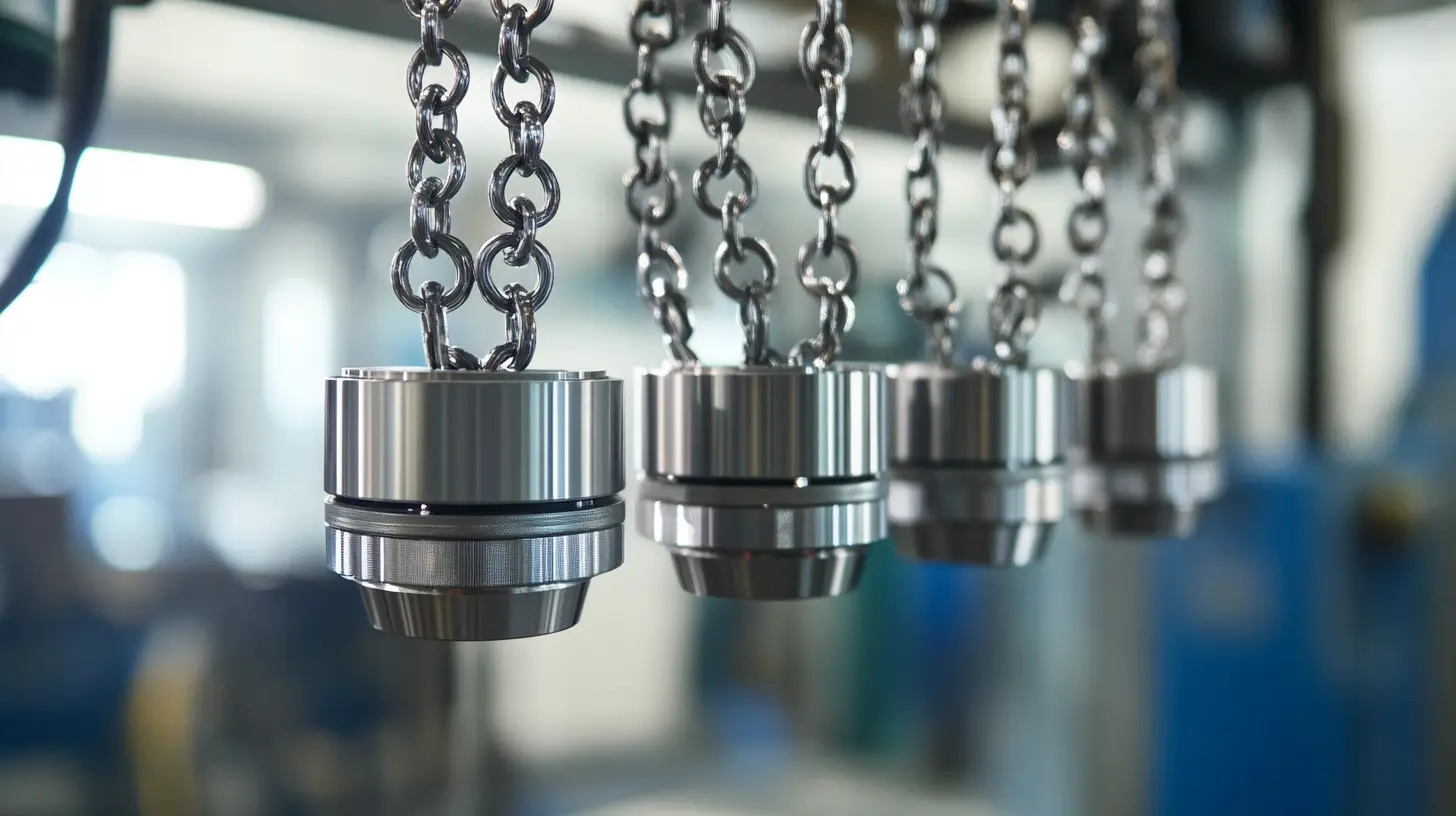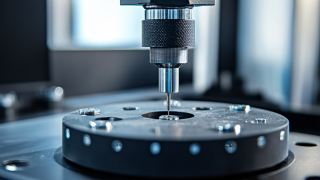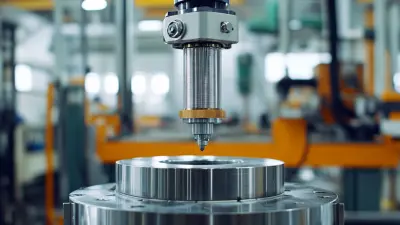 [email protected]
[email protected] 
-
Home
-
Products
-
News
-
About Us
-
Contact Us
Leave Your Message
-
 CONTACT LCS TECH
CONTACT LCS TECH -
 CONTACT LCS TECH
CONTACT LCS TECH



In the ever-transforming space of automation, precision and reliability in manufacturing processes are becoming all the more crucial nowadays. An important invention in driving this process would be Compression Load Cells, which in turn have an important role in measuring force and weight in an accurate manner across different applications. These advanced sensors increase efficiency in operations and also improve the quality of the products being manufactured, thus becoming the two most important features in the arsenal of manufacturers worldwide. So, with this competitive edge, it is essential that industries understand what Compression Load Cells can do for them in transforming their companies.
Founded in 2012, LCS Tech Co., Ltd. has been keeping pace with this advancement in technology since the time of its establishment. With advanced strain gauge technology as the sine qua-non of our operations, we manufacture load cells, force sensors, and torque transducers to world standards of quality for the global market in over 40 countries. Our excellence truly reflects the "Made in China" spirit and gives manufacturers a peace of mind that they have a trusted partner in implementing world-class automation solutions. The following, therefore, is a blog post that will discuss 5 main benefits of Compression Load Cells, together with innovative automation applications that can aid them in improving manufacturing standards to a greater extent in the global market.

The compression load cell is the equipment of choice for the modern-day manufacturing sector with a view to enhance efficiency and accuracy. The importance of load cells lies in their precise measurement of the forces exerted by materials or components being manufactured. MarketsandMarkets reports suggest that the global load cell market is poised to touch $4 billion by 2025, thus validating advanced measurement technologies for optimization of manufacturing workflows. Some of the chief merits of compression load cells are the provision of real-time force measurement and control of product quality. The integration of such sensors into an automated system allows manufacturers to ensure product consistency throughout their operations. For example, accurate weight measurement allows close control during material handling and minimizes wastage or prevents costly errors during production. The International Journal of Advanced Manufacturing Technology has reported a 20% reduction in waste attributed to improved weighing accuracy associated with load cell technology use by companies. Moreover, load cells, through the application of compression-technique, also lend themselves to preventative maintenance in the manufacturing world. Being able to register variations in a load, a company is then able to issue warnings relative to impending equipment failure and hence reduce losses from downtime. The Journal of Manufacturing Science and Engineering mentioned a substantial decline in maintenance costs due to predictive maintenance-up to 30%-allowing companies to better allocate resources and enhance productivity. Finally, while enhancing measurement precision and improving operations, the integration of compression load cells also leads to a culture of continuous improvement in manufacturing practices. Thus, innovative applications of this technology will undertake a strong influence on the future of automated production systems as world manufacturers seek to remain competitive.

The integration of advanced technologies is the way to go in terms of precision and accuracy of automated systems in today's fast-paced manufacturing environment. The compression load cells are also becoming crucial in achieving these goals. By precisely measuring the force and load in automated processes, these sensors are able to increase production efficiency and ensure that the data that form the basis for decision-making are trustworthy.
Increased automation efficiency of systems is gained by using compression load cells. These devices measure the loads applied by the actions of the machinery in real time, and thus encourage optimal performance and minimize downtime. The measurement of various loads with high accuracy provides the manufacturers with a way of assuring stringency in quality control. Besides, as industries move to IoT, the data from load cells can be easily integrated into other systems, thus giving rise to smarter and responsive manufacturing operations.
While global manufacturers keep implementing innovative ideas to bring about productivity, the use of compression force load cells cannot be overstressed. Enhanced accuracy means not just an improvement in the product quality but also, by reducing overload cases, safety enhancement. With increased research and development efforts in sensor technology, manufacturers look forward to further enhancements in their automation processes, driving greater levels of efficiency and reliability along production lines.

The introduction of real-time data monitoring has drastically changed the paradigm of automation in manufacturing. Compression load cells play a very important role in this transformation, enabling manufacturers to record critical force and weight data during industrial processes. As reported by MarketsandMarkets, the load cell market has been projected to grow from $1.1 billion in 2021 to $1.6 billion in 2026, fueled by an increasing demand for precise measurement and monitoring solutions in various industrial applications.
Real-time data monitoring using compression load cells enables manufacturers to receive information regarding the live measurements of their production lines, thereby enhancing their decision-making process. The load cells continually weigh in on operating performance, allowing for immediate corrections to be carried out. A research report by Deloitte states that up to 20% increase in productivity could be achieved with real-time applications considering that businesses can determine inefficiencies and bring corrective action before they turn into expensive downtime.
In addition, integration of compression load cells into automation ensures predictive maintenance. Load conditions are monitored at all times, enabling manufacturers to foresee equipment failure and schedule maintenance accordingly. The McKinsey report suggests that predictive maintenance can lower the cost of maintenance by 20-25% while simultaneously enhancing the life of the assets. The predictive maintenance approach not only saves operational costs; however, it also maximizes uptime from production efficiency perspectives.
All in all, the innovative use of compression load cells in automation range strongly via real-time data monitoring for enhanced efficiency, preventive maintenance, and beneficial decision-making. With the ongoing transformation of the industry, embracing such technology will be key for manufacturers striving to stay ahead of the competition in the international arena.

Adapting to the ever-changing environment of global manufacturing, businesses are contending with fixed budgets in order to lessen costs in their operational activities through smart automation solutions. A new strutting technology causing big waves in the industry is none other than the compression load cell. The compression load cells have been dedicated for more production function improvement indication and efficiency enhancement in automation systems due to their ability to capture significantly precise readings of force and weight.
Integration of compression load cells into automated workflows allows finer muscle control in production lines. Such accuracy creates the capability of realtime monitoring and data capture, which allows for immediate corrective action changes during variations in product quality or material consumption. Waste and flooring renovation are effectively minimized, the overall cost of operations is then reduced.
Further, adopting compression load cells could help predictive maintenance strategies. It enables monitoring of the load conditions of machines durably and performance state of production facility, allowing production companies to analyze and predict possible issues before incurring huge costs for stopping operations. This is both fruitful and prolonging machine lifetime which ultimately saves more cost as well. As this adoption continues on progress in smart automating methods, the major benefits from introduction of advanced sensing technologies are not far from realization.
The quest for product quality and consistency is vital in the present competitive environment of manufacturing. One of the novel introductions in this respect is inserting the compression load cell technology within the automation process. These devices provide accurate weight measurement and act as quality controllers for the products so that the specifications are met without variability.
Compression load cells allow manufacturers to monitor the weight of finished products on the production floor and make real-time adjustments during the production process. This means that corrective action can be taken immediately to reduce waste and defective products. In the food and beverage industry, for example, where consistency is king, load cells ensure that every pack carries that exact amount of product through the customer experience.
This endeavor also creates a more streamlined production line due to the presence of load cell technology. With automated systems fitted with these sensors, manufacturers are much more efficient and reliable. This speeds up the process while also significantly minimizing human error. The load cell analytics also provide companies with the opportunity to take data-driven decisions that will continuously improve their product development and processes. Therefore, through this means, the manufacturers are improving the quality of output and setting new standards of excellence worldwide.
Integration of the use of compression load cells in factories make up most of the automation processes in industry today. These machines make for precision measuring of compressive forces, which goes a long way to monitor the equipment's stability and help in operational proficiency. When compression load cells are embedded into the machinery and eventually the production lines, they help manufacturers realize live stresses which would have otherwise gone unnoticed and thus make timely interventions to prevent accidents.
By having different compression load cells in place, it also transforms a workplace into a safer working environment through predictive maintenance. Monitoring a machine's current load has with it preemptive aspects that could foresee disintegrating parts before pranging an accident risk on men and machines. Such an idea of taking the world towards a proactive stance leads to always fewer accidents happening related to malfunctions in production machinery.
More so, the application of load cells will ensure compliance with safety laws and standards. Using more data practically combined with deeper analysis of spending patterns, manufacturers will also be able to testify their commitment to workplace safety, which will also help reduce costs incurred through fines or penalties. Sourcing a safe environment from a safety engineering commitment portrays to factories how such a commitment should be sculpted.
Innovation in the application of compression load cells in automation is becoming very important for global manufacturers because it is seen to bring several benefits to the streamlining and productivity of operations. The recent case studies describing how companies are using this technology in the optimization of their processes clearly illustrate its transformative effect on manufacturing lines.
Compression load cells have been adopted by one of the top brands for quality checks on its assembly lines. The number of products wrongly defected was reduced by up to 30% by measuring loads accurately. Only those which meet appropriate specifications were shipped. This case is fairly representative of a trend, as industry papers state that 80% of companies have had a radical improvement in product consistency and overall operational efficiency.
Meanwhile, another company has added compression load cells with its existing automation framework for data to be collected and analyzed in real time with the aim of speeding up the decision-making process and causing a waste reduction by 25% along with an increase in throughput by 40%. Statistically analyzed, these implementations result in operational costs reduced by as much as 20%, according to some of the latest studies done across various sectors.
It becomes clearer as the examples accumulate that the manufacturing landscape is increasingly converging toward the idea that novel applications of compression load cells represent the future of smarter and greener manufacturing. Bridging old techniques with advanced technologies points not only towards productivity improvements for manufacturers but also lays the foundation for international measures of practice excellence.
Transformation in Role: Compression load cells in global manufacturing are rapidly evolving because on the other hand, industries are being automated and engineered with smart technologies. Yet, these become more visible when integrated with the automated system of a manufacturing plant for modernization in production efficiency and productivity improvements. Ideal applications go beyond measuring force and weight to also include real-time feedback data for decision-making purposes on the shop floor.
One of the influencing factors to actuator future structure is the proliferation of IoT (Internet of Things) technology. Connecting sensors to cloud-based platforms would allow manufacturers to remotely monitor performance of machines and product quality, theoretically enabling predictive maintenance, minimizing downtime and optimizing operations. The most interesting outcome being a shift of compression load cells from mere measuring devices to functional parts of smart manufacturing systems.
Also, the thirst for data-induced insights has prompted manufacturers to adopt new analytics alongside compression load cells. In conjunction with big data technology, performance metrics from these devices are analyzed by companies to find waste and optimize operations. This "redefining" also does wonders to operations efficiency as well as quality control measures leading to better products and satisfaction of the customers in the competitive global market.
Compression load cells are devices that measure force and weight with high precision. They help manufacturers achieve finer control over production lines, enabling real-time monitoring and data collection to improve efficiency and quality.
By optimizing processes and enhancing efficiency, compression load cells reduce waste and rework, which directly lowers operational costs. They also support predictive maintenance, helping identify potential issues before they result in costly downtime.
A leading manufacturer used compression load cells to improve quality control in assembly lines, reducing product defects by 30%. This demonstrates their effectiveness in ensuring that only high-quality items are shipped.
Businesses adopting compression load cells often report significant improvements, such as a 25% reduction in waste and a 40% increase in throughput, leading to overall reductions in operational costs by up to 20%.
IoT technology allows compression load cells to connect to cloud-based platforms, enabling remote monitoring of machine performance and product quality, which enhances predictive maintenance and operational optimization.
Manufacturers are increasingly using advanced analytics with data from compression load cells to identify inefficiencies and improve processes, enhancing operational efficiency and quality control for better product outcomes.
Key trends include the integration of IoT technology, the demand for real-time data, and the use of big data analytics to strengthen operational efficiency and quality control in manufacturing settings.
Compression load cells provide real-time data that allows manufacturers to monitor product quality continuously, leading to better control measures and improved customer satisfaction.
Long-term benefits include reduced operational costs, extended lifespan of machinery, improved product consistency, and setting benchmarks for industry standards through smarter manufacturing practices.
Compression load cells continuously monitor load conditions and equipment performance, allowing manufacturers to identify potential issues early, reducing downtime and maintenance costs.




